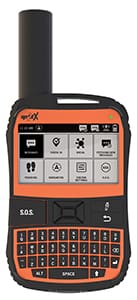Satcom that you can hold in the palm of your hand: That’s the essence of two simple satcom units that not only fulfill a communications function, but a safety role as well. The Garmin inReach and the recently introduced SPOT X both allow for simple text messages and preconfigured texts to be sent via satellite to your friends and family or rescue authorities. A fantastic safety tool for wide-ranging ocean voyagers, it can be used ashore too, providing communications and assistance when you are hiking or traveling far from your boat.
Until last May, when SPOT introduced the SPOT X unit, the only two-way hand-held satellite communicator was the inReach. The inReach was originally developed by the DeLorme Company, which was purchased by Garmin in 2016. The original inReach unit debuted in 2011. For satellite connectivity it used the Iridium system, giving it worldwide coverage. The first inReach was designed to be used with a cellphone for sending 160-character texts via Iridium short-burst data, but it had no physical or virtual keyboard. To type a message, you used a Bluetooth-linked smartphone and the inReach would send the message when you were ready. It could also send an SOS message at the touch of a button. This first inReach also had a built-in GPS receiver for tracking and providing positions for the SOS function and the message function.
Soon after, the inReach was upgraded with its own screen and virtual keyboard. This removed the need for a smartphone (although the inReach can still be linked with a smartphone for typing messages), making it a standalone unit that proved even more appealing not only to boaters but to hikers and just about anyone venturing outdoors and wanting to stay in touch.
Garmin has rebranded the inReach as a Garmin product, now called the inReach Explorer+, and continues to upgrade it — for example, by bringing in weather capability.
Before DeLorme even developed the inReach, there already was a satellite tracking and messaging option called SPOT. Unlike the inReach, SPOT used the Globalstar satellite network, which has less coverage than Iridium but still covers most areas voyagers usually sail.
The SPOT units were set up as trackers with the ability to do one-way messaging. The messages were of the canned variety, such as an SOS message, “Everything’s okay,” etc. There was no display screen and no way for users to receive incoming messages. Even with this limited one-way messaging setup, the original SPOT devices were widely used by mariners and outdoor adventurers alike.
Then, in May of 2018, SPOT released the SPOT X, a whole new level of SPOT capability. Whereas the previous lineup of SPOT devices had no screen, the SPOT X has a 2.7-inch backlit screen, plus an illuminated QWERTY keyboard.
The screen and keyboard mean that the SPOT X can send and receive text messages with any phone or email address. SPOT designers have retained the instant SOS button and another nice SPOT feature: You still can send an “Everything’s okay” message with the touch of one dedicated button. If you do need to use the SOS emergency button, you’ll be connected to 24/7 search and rescue services through the GEOS International Emergency Response Coordination Center.
The SPOT X also comes with a dedicated mobile phone number, a built-in compass, the capability to link to your Facebook and Twitter accounts and, of course, a built-in GPS receiver with a robust tracking feature. You can select from 2.5-, 5-, 10-, 30- or 60-minute tracking intervals.
The added functionality of two-way messaging makes the SPOT X an attractive competitor to the inReach. And the lower equipment price of $250 for the SPOT X — compared to $450 for the inReach Explorer+ — doesn’t hurt.
Around the time the SPOT X came out, Garmin released a new model of the inReach called the inReach Mini ($350). It’s smaller, of course, than the Explorer+ and weighs in at 3.5 ounces. Some of the functionality of the bigger inReach has been removed to make this small unit. But it still can send and receive text messages via Iridium satellite using either the unit’s own virtual keyboard or by connecting it to your smartphone.
Which one of these units is best for you? That question naturally involves a matrix of many considerations, from the way you use it, to the extent of voyaging you do, to the price of the unit, to the cost and flexibility of the subscription plans.
Overall, though, the world of hand-held satellite communications devices appears to be in good hands.

